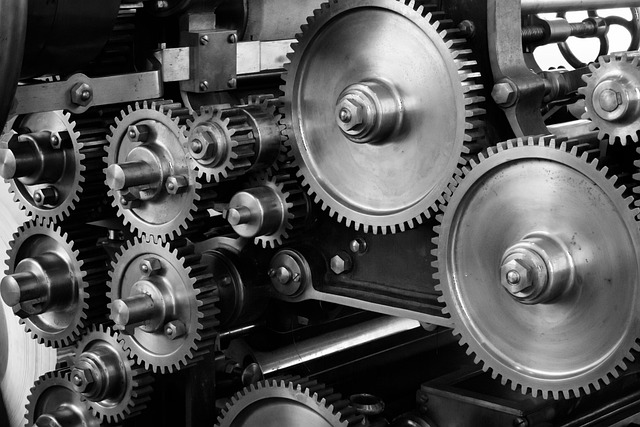Sprockets and gears are two different types of mechanical devices used to transfer motion. Sprockets have teeth that engage with a chain or belt while gears use meshed teeth to transmit power between rotating shafts.
What is a sprocket?
(Photo By Photo by LouisMoto on Unsplash)

A sprocket is a wheel with teeth that meshes with the links of a chain, track, or other perforated or indented material. They are used in bicycles, motorcycles, cars, and other machinery either to transmit rotary motion between two rotating shafts where gears are unsuitable or to provide linear motion. Sprockets are similar to gears in that they are also rotating machine parts with teeth, but they are typically used for the purpose of propelling a chain forward.
What is gear?
(Photo By Image by MustangJoe from Pixabay)

A gear is a rotating machine part with teeth, cogs, or spines that mesh with another toothed part in order to transmit torque. Gears can be used to change the speed, direction, and torque of a moving object.
The difference between a sprocket and a gear
The two main differences between them are the way they mesh together and the type of load they carry. Gears have teeth that mesh together in order to transfer rotational force, while sprockets have pins that engage with a chain to transfer linear force. The type of load also affects the choice between gears and sprockets. Heavier loads are typically carried by gears, while lighter loads can be carried by either type of device.
When to use a sprocket vs. a gear
When it comes to choosing between a sprocket and gear, the first question is typically what sort of load will be placed on the device. If the answer is a light load at a low speed, then a sprocket is likely the best option. Sprockets are also often used in applications where there isn’t a need for high precision, such as on bicycles. On the other hand, if higher loads and speeds are required, then gears become a more attractive option because they can better handle those conditions. Additionally, gears offer more precision than sprockets and are often used in power transmission applications where reduced backlash is necessary.
How to choose the right size sprocket or gear
There are a few factors to consider when choosing the right size sprocket or gear for your needs.
The first is the application – what will the sprocket or gear be used for? If it’s for a bicycle, then you’ll need to take into account the size of the wheels and the type of terrain you’ll be riding on. If it’s for a car, then you’ll need to consider the engine size and transmission.
The second factor is the material. Sprockets and gears are typically made from steel, aluminum, or brass. Each material has its own benefits and drawbacks, so you’ll need to decide which one is right for your needs.
Finally, you’ll need to consider the cost. Sprockets and gears can range in price from a few dollars to hundreds of dollars. Again, it all depends on the materials and the application.
By taking all of these factors into account, you should be able to find the perfect sprocket or gear for your needs.
What are the 3 types of gears?
There are three types of gears: Spur, Helical, and Bevel.
Spur gears have teeth that are parallel to the shaft.
Helical gears have teeth that are at an angle to the shaft.
Bevel gears have teeth that are perpendicular to the shaft.

Do bigger gears go faster?
There is a common misconception that bigger gears always mean more speed. However, this is not necessarily true. While it is true that bigger gears can provide more speed, they also come with some drawbacks.
For example, bigger gears are often heavier than smaller ones, which can impact the overall performance of your bike. Additionally, they can be more difficult to pedaling, especially if you are not used to them.
Ultimately, it is up to you to decide whether or not bigger gears are right for you. If you are looking for more speed, then they may be a good option. However, keep in mind the potential drawbacks before making your decision.
What are the disadvantages of gears and sprockets?
Gears
There are a few disadvantages of gears when compared to other mechanical systems. They can be more expensive to produce, and they require more maintenance than some other types of systems. Gears can also be less efficient than other types of systems, and they can generate more noise.
Sprockets
There are a few disadvantages of sprockets when compared to gears. First, sprockets are more likely to slip under load than gears. This can be a problem if the application is one where high torque or precision is required. Second, sprockets are also more likely to produce vibration and noise than gears. This can be an issue in applications where smooth operation is desired. Finally, sprockets are generally not as strong as gears and may require frequent replacement or adjustment.
Which is the strongest gear and why?
There are a few different factors to consider when determining which is the strongest gear. One is the material the gear is made from. For example, a steel gear will be stronger than one made from plastic. Another factor to consider is the size of the gear. A larger gear will typically be stronger than a smaller one. Finally, the teeth on the gear also play a role in its strength. Gears with more teeth will generally be stronger than those with fewer teeth.
Frequently asked questions about sprockets and gears
What is the gear ratio?
The gear ratio is the number of teeth on the driven sprocket divided by the number of teeth on the drive sprocket. For example, if the driven sprocket has 30 teeth and the drive sprocket has 10 teeth, the gear ratio is 3:1.
Is sprocket a type of gear?
Sprockets are not a type of gear, but rather a type of pulley. Gears are toothed wheels that mesh together in order to transfer rotational force, while sprockets are simply toothed wheels that work with chains or belts. Sprockets can be used with gears, however, as part of a gear system.
What device uses gears?
Gears are used in a variety of devices, from simple machines like can openers to complex ones like automobiles. In a gear, teeth on the inner circumference of a wheel mesh with teeth on an outer ring. The gears work together to transfer rotational force from one to the other.
Where are sprockets used?
There are many places where sprockets are used, but they are most commonly used in bicycles and motorcycles. Sprockets are also used in other machinery, such as printers, copies, and fax machines.
How do I identify a sprocket?
There are a few different ways that you can identify a sprocket. One way is by the teeth on the edge of the sprocket. Another way is by the way the sprocket is mounted (i.e., on a shaft or in a housing). Lastly, you can also identify a sprocket by its function (i.e., it is used to transfer rotational motion).
What’s a camshaft sprocket?
A camshaft sprocket is a toothed wheel that sits on the end of the camshaft. The teeth on the sprocket engage with the teeth on the timing belt, which turns the camshaft.
What size sprocket is faster?
There is no definitive answer to this question as it depends on a number of factors, such as the size of the chain, the type of chain, the ratio of the sprocket, and the terrain. In general, however, a smaller sprocket will be faster than a larger one. This is because a smaller sprocket has less rotational mass, which means it can accelerate and decelerate more quickly. Additionally, a smaller sprocket will eat up less of the chain, which can also help to speed up the bike.
Featured Image by Wilhelm Gunkel on Unsplash








